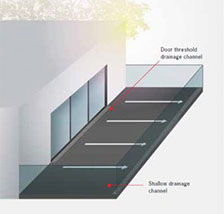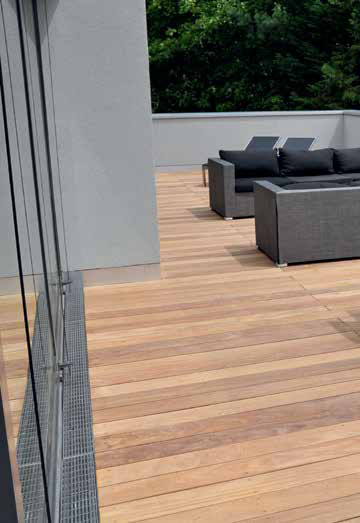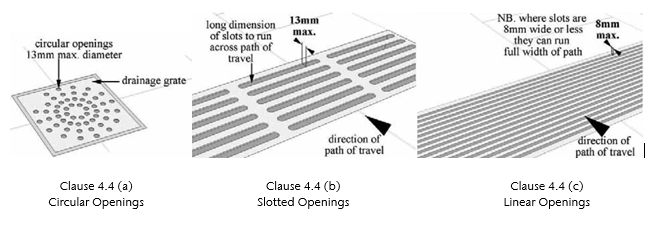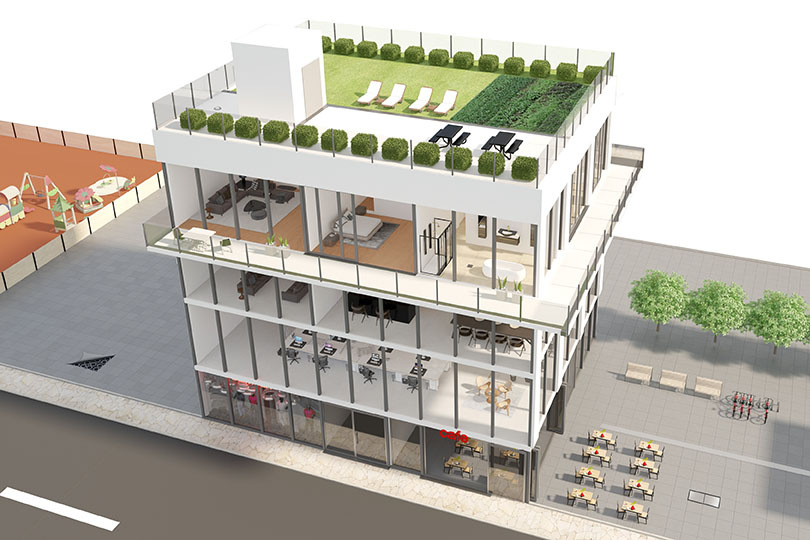Choosing the right drainage system
The requirements of a drainage system differ widely across specifc applications within a building. Each drainage element must be carefully considered to assess their visual and functional impact on a buildings design.
The aesthetics of a drainage system must be carefully considered to ensure it is consistent with the designer’s visual project objectives.
Selecting drainage that enhances or blends with the aesthetic is an important consideration as drainage is used frequently across commercial and residential buildings.
Buildings visually and physically interact with the environment. The visual integration of drainage into a building’s architecture is extremely important. Visual continuity throughout a project is a subtlety within building design. Designers specifying the same grate type throughout a building, whether it be in a courtyard, balcony or bathroom creates continuity of design.
Grates could either harmonise with the design of the building or become a feature element. For instance, longitudinal grates can accentuate the sleek lines of a building in contrast to tile grates which can be used to blend seamlessly with the pavement and surrounds.
Products must be compliant with Australian Standards. WaterMark is an Australian certifcation for plumbing products, including drainage. All of ACO’s stainless steel drainage products are WaterMark certified for compliance.
To ensure a building and its elements have the appropriate barrier protection, an assessment of the hydraulic capacity of both the channel and grate is essential.
A correctly specifed drainage system stops rainwater transgressing into a building or into other sensitive areas. Catchment hydraulics are site-specifc and therefore require specifc calculations to ensure drainage systems are correctly selected and sized.
To read more about this below.

A channel’s hydraulic capacity is calculated by the amount of water the channel is able to collect and drain in a given time period. This determines the size of channel required.
One way to alter a channels capacity is by changing its physical cross sectional size (width x depth). The other is by changing its hydraulic run length. This is defined as the distance water needs to travel before being discharged through an outlet. Changing this can dramatically alter a channel’s run capacity. With all other factors equal, the shorter a hydraulic run length, the higher a channels capacity to drain.
A grate fails hydraulically when water bypass occurs. Consideration must also be given to the inlet size of the grate to ensure it adequately removes water, but not at the expense of introducing litter into the drainage system, or compromise the safety of users.
A grate’s hydraulic capacity is calculated by the amount of water it will allow to pass through it in a given time period. Failure to allow passage of water into its underlying channel will result in bypass, regardless of how much capacity the channel has.
There are three factors that affect the hydraulic capacity of a grate, its size, its collective intake area and the design of its inlets.
For instance, a longitudinal bar grate can have a large cumulative intake area. Between the bars, each slot acts as an individual elongated orifice and the grate will only reach its capacity once each orifice has flooded. The bars also have the effect of slowing down the speed of water, ensuring gravity has enough time to maximise the evacuation of the water between the bars.
 In comparison, the intake areas (and therefore capacity) of Tile and Brickslot grates are much smaller than a longitudinal bar design. A Tile grate has only two openings along the length of the drain. There are fewer opportunities for water to be evacuated through the design.
In comparison, the intake areas (and therefore capacity) of Tile and Brickslot grates are much smaller than a longitudinal bar design. A Tile grate has only two openings along the length of the drain. There are fewer opportunities for water to be evacuated through the design.

Furthermore, Brickslot grate styles are the most compromised design as there is only one slot for water to be interrupted and slowed.
 During heavy storms, water bridging is common due to the increased flow rate. This can result in bypass, so longitudinal bar grates are preferred in vulnerable areas.
During heavy storms, water bridging is common due to the increased flow rate. This can result in bypass, so longitudinal bar grates are preferred in vulnerable areas.
 Flat and level pavement design reduces risks to pedestrian safety, but requires an efficient drainage system to prevent hazards caused by ponding and standing water, damage to buildings and to preserve the life of the pavement.
Flat and level pavement design reduces risks to pedestrian safety, but requires an efficient drainage system to prevent hazards caused by ponding and standing water, damage to buildings and to preserve the life of the pavement.
Balconies are popular in multi-residential buildings to ensure occupants have access to outdoor space. AS 3500.3 specifies that balconies and terraces should be designed with two drainage methods. One designed for a 20 year storm event (to drain rain from walls, windows and wind driven rain collecting on the door frame and prevent the aluminium sub sill from flooding), and an alternative, contingency method designed for a 100 year storm event.
It is imperative that the exposed area falls away from the building, so any threshold drainage is designed to remove only wind driven rain and not surface runoff from the pavement.
 To make the most of the Australian climate, open air living and working areas are popular. This has meant that level thresholds have become a sought after design feature in many residential and commercial buildings leaving sleek, distinct architectural lines for the designer to integrate. These lines are often the regularly trafficked access zones of buildings and become the barriers between wet and dry areas.
To make the most of the Australian climate, open air living and working areas are popular. This has meant that level thresholds have become a sought after design feature in many residential and commercial buildings leaving sleek, distinct architectural lines for the designer to integrate. These lines are often the regularly trafficked access zones of buildings and become the barriers between wet and dry areas.
Stormwater drainage must be effective as water damage repairs are not only disruptive and extremely costly, but can have legal ramifications in the event of structural damage or injury from standing water.
With the increasing regularity and intensity of storm events, linear drainage is an effective barrier to stop water transgression into buildings and other sensitive areas. Drainage must be correctly specified to ensure performance even during peak storms.
Factors to consider are:
- The speed and volume of run off from the exposed pavement, or facade,
- Relative position of the drain,
- The hydraulic performance of the drainage channel
- The inlet performance of the grate
For every application consider:
- Traffic flow: bare feet, heels, vehicles
- Local environment: proximity to the ocean, a swimming pool or other harsh environment
- Legislative requirements: slip resistance, aesthetics, load ratings

Building thresholds are highly trafficked making access and mobility an imperative consideration. Designers must cater for a diverse occupancy driven by a number of factors including an ageing population as well as disability requirements. Level threshold drainage in buildings facilitates access and eliminates the need to have conventional step downs that were once used to contain stormwater runoff.
There are a number of regulatory and user requirements that designers must be aware of when specify drainage channels.
AS 1428.1:2021 includes, Section 4 Floor or ground surfaces on continuous accessible paths of travel and circulation spaces, with Clause 4.4 Grates which states the following:
“Grates in paths of travel shall be in accordance with the following:
(a) Circular openings shall be not greater than 13mm in diameter.
(b) Slotted openings shall be not greater than 13mm wide and not greater than 150mm long and be oriented so that the long dimension is transverse to the dominant direction of travel.
(c) Linear openings shall be oriented so that the longer dimension is transverse to the dominant direction of travel, except where linear openings are less than 8mm wide. Where linear openings are less than 8mm wide, orientation is optional.”

If the grates meet AS 1428.1, they are deemed to comply with DDA requirements.
To learn more about wheelchair and walking cane compliance, visit ACO’s education pages.
With the increase in litigation and compensation for injuries caused by slips, trips and falls, designers must consider specifying grates and floor surfaces that comply with AS 4586 – Slip resistance classifications of new pedestrian surface materials. It is important for designers to specify a grate that is relevant for the application with a suitable slip resistance rating.
The perception that a higher slip resistance rating will provide a better solution is incorrect. Trip hazards can be introduced where a grate has a higher slip resistance than the surrounding floor surface, or vice versa. ACO recommends grates to have the same level of slip resistance as the surrounding floor.
The slip resistance of Tile and Brickslot grates depend on the slip resistance of the infill material specified. In order to measure the slip resistance of a grate or floor surface, three tests are specified in AS 4586.
- Wet pendulum: Applied to pedestrian areas that can become wet with rainwater.
- Wet-barefoot inclining platform: Applied to wet areas where footwear/shoes are not worn. For instance at pools, waterparks, beach areas etc.
- Oil-wet inclining platform: Applied for commercial and industrial areas that can be contaminated with oil or grease e.g commercial kitchens.
Slip resistance standards
The National Construction Code (NCC) requires and specifies minimum slip classifications for certain, high-risk areas. The table below is adapted from the National Construction Code 2016, volume 1 and 2.
In 2014, Standards Australia published a supporting handbook, HB 198:2014 Guide to the specification and testing of slip resistance of pedestrian surfaces, which provides recommendations and guidance for specifying surface materials that suit different application requirements. The adjacent table details guidance from HB 198. To assist designers in specifying grates with adequate slip resistance, ACO has commissioned and independent third party authority to test and rate each of its grates to AS 4586.

| Location | Wet pendulum Dry surface |
Wet pendulum Wet surface |
Wet ramp Dry surface |
Wet ramp Wet surface |
|---|---|---|---|---|
| Ramp steeper than 1:14 | P4 | P5 | R11 | R12 |
| Ramp steeper than 1:20, but not steeper than 1:14 | P3 | P4 | R10 | R11 |
| Ramp not steeper than 1:8 | P4 | P5 | R10 | R12 |
| Tread surface | P3 | R10 | R10 | R11 |
| Nosing or landing edge strip | P3 | - | P4 | - |
| Location | Wet pendulum test |
Inclining platform test |
|---|---|---|
| External Pavements and Ramps | ||
| External ramps including sloping driveways and footpaths steeper than 1:14 | P5 | R12 |
| External ramps including sloping driveways and footpaths, etc., under 1:14, external sales areas (e.g. markets), external carpark areas, external colonnades, walkways, pedestrian crossings, balconies, verandas, carports, driveways, courtyards and roof decks | P4 | R11 |
| Undercover car parks | P3 | R10 |
| Hotels, Offices, Public Buildings, Schools and Kindergartens | ||
| Wet areas | P3 | R10 |
| Transitional areas | P2 | R9 |
| Dry areas | P1 | R9 |
| Toilet facilities in offices, hotels and shopping centres | P3 | R9 |
| Hotel apartment bathrooms, en-suites and toilets | P2 | A |
| Hotel apartment kitchens and laundries | P2 | R9 |
| Supermarkets and Shopping Centres | ||
| Fast food outlets, buffet food areas, food courts and dining areas in shopping centres | P3 | R10 |
| Shops and supermarket fresh fruit and vegetable areas | P3 | R10 |
| Shop entry areas with external entrances | P3 | R10 |
| Supermarket aisles (except fresh food areas) | P1 | R9 |
| Other separate shops inside shopping centres – wet | P3 | R10 |
| Other separate shops inside shopping centres – dry | P1 | R9 |
| Loading Docks, Commercial Kitchens, Cold Stores, Serving Areas | ||
| Loading docks under cover and commercial kitchens | P5 | R12 |
| Serving areas behind bars in public hotels and clubs, cold stores and freezers | P4 | R11 |
| Swimming Pools and Sporting Facilities | ||
| Swimming pool ramps and stairs leading to water | P5 | C |
| Swimming pool surrounds and communal shower rooms | P4 | B |
| Communal changing rooms | P3 | A |
| Undercover concourse areas of sports stadiums | P3 | R10 |
| Hospital and Aged Care Facilities | ||
| Bathrooms and ensuites in hospitals and aged care facilities | P3 | B |
| Wards and corridors in hospitals and aged care facilities | P2 | R9 |
CPD training
In today’s ever-changing construction industry, it has never been more important to ensure you are up to date with current industry regulations, practices, trends and innovations.
With a series of free Continuing Professional Development (CPD) and industry specific courses, we provide essential learning and knowledge to construction professionals, ensuring you can undertake professional development when and where you need it.
Continuous professional development is a commitment required by chartered bodies to develop your career and encourage lifelong learning. Some courses have been accredited by professional associations such as Engineers Australia (EA), Australian Institute of Landscape Architects (AILA) and Architectural Information Services (AIS).

Click here to view all courses.







